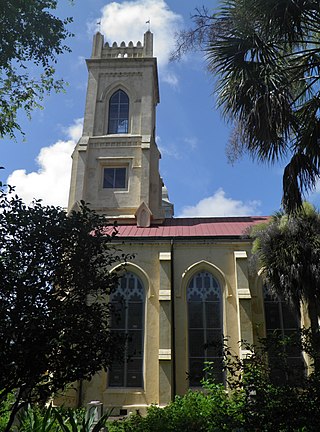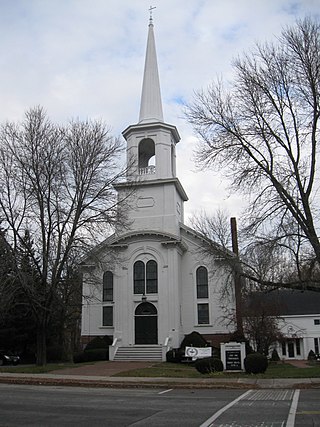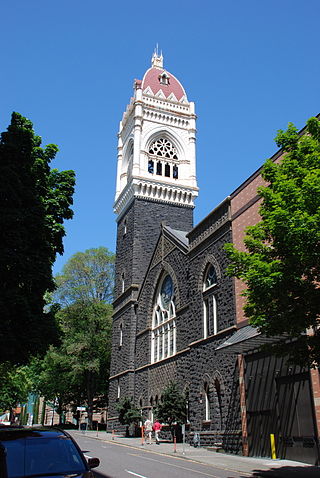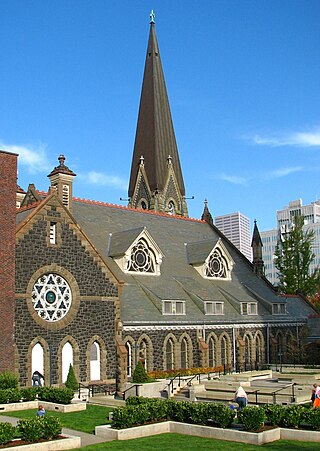
Unity Temple is a Unitarian Universalist church in Oak Park, Illinois, and the home of the Unity Temple Unitarian Universalist Congregation. It was designed by the American architect Frank Lloyd Wright, and built between 1905 and 1908. Unity Temple is considered to be one of Wright's most important structures dating from the first decade of the twentieth century. Because of its consolidation of aesthetic intent and structure through use of a single material, reinforced concrete, Unity Temple is considered by many architects to be the first modern building in the world. This idea became of central importance to the modern architects who followed Wright, such as Ludwig Mies van der Rohe, and even the post-modernists, such as Frank Gehry. In 2019, along with seven other buildings designed by Wright in the 20th century, Unity Temple was added to the UNESCO World Heritage List.

The Arlington Street Church is a Unitarian Universalist church across from the Public Garden in Boston, Massachusetts. Because of its geographic prominence and the notable ministers who have served the congregation, the church is considered to be among the most historically important in American Unitarianism and Unitarian Universalism. Completed in 1861, it was designed by Arthur Gilman and Gridley James Fox Bryant to resemble James Gibbs' St. Martin-in-the-Fields in London. The main sanctuary space has 16 large-scale stained-glass windows installed by Tiffany Studios from 1899 to 1930.

The Unitarian Church in Charleston, home to a Unitarian Universalist congregation, is an historic church located at 4 Archdale Street in Charleston, South Carolina. It is the oldest Unitarian church in the South and the second oldest church building on the peninsula of Charleston.

As of 2007 there are five church buildings in the Sycamore Historic District, located in Sycamore, Illinois, United States which are listed as contributing properties to the district. The Sycamore Historic District was added to the U.S. National Register of Historic Places on May 2, 1978. When it was nominated to join the National Register there were seven church buildings within the district. One of those included is a residential structure that was utilized as a church when it was first constructed; the Arthur Stark House was once home to the Sycamore Universalist Church congregation. In the time since its listing, two churches have been destroyed or demolished. The Evangelical Lutheran Church of St. John was destroyed by fire in 2004 and the United Methodist Church in Sycamore is no longer extant, replaced by a modern office building.

First Unitarian Church is a historic congregation of the Unitarian Universalist Association in Cincinnati, Ohio, United States. Founded in the early nineteenth century, it survived a series of division and reunifications in the nineteenth century. Among the people who have worshipped in its historic church building on the city's northern side are many members of the Taft family, including William Howard Taft, the President of the United States.

First Unitarian Congregational Society in Brooklyn is a Unitarian Universalist congregation in Brooklyn, NY. The Society was established in 1833 and has been worshiping in its historic Gothic Revival Sanctuary since 1844. The Sanctuary is adorned with stained glass windows and a Louis C. Tiffany angel mosaic. It is one of the earliest Unitarian congregations in the United States, established just 8 years after the American Unitarian Association was formed in 1825.

The First Unitarian Church of Detroit was located at 2870 Woodward Avenue in Midtown Detroit, Michigan. Built between 1889 and 1890, it was listed on the National Register of Historic Places in 1982. It was destroyed by fire on May 10, 2014.

Unitarian Memorial Church is a historic church on 102 Green Street in Fairhaven, Massachusetts, home to the Unitarian Universalist Society of Fairhaven.

The former First Unitarian Church is a historic church building at 130 Highland Avenue in Somerville, Massachusetts. The stone church was built in 1894 for a Unitarian congregation. It was designed by Hartwell & Richardson and is a good example of Richardsonian Romanesque design. The building presently (2022) houses the Mission Church of Our Lord Jesus Christ.

First Parish Church in Plymouth is a historic Unitarian Universalist church at the base of Burial Hill on the town square off Leyden Street in Plymouth, Massachusetts. The congregation was founded in 1620 by the Pilgrims in Plymouth. The current building was constructed in 1899.

The Unitarian Universalist Church is a historic church at 20 Forest Street in Stamford, Connecticut. It is a modestly-sized Gothic Revival structure, built out of fieldstone, brick, and granite, in 1870 to a design by Stamford architect Gage Inslee. While most of its exterior windows are stenciled in imitation of stained glass, it has two genuine stained glass windows in the choir loft that are between 400 and 700 years old, and were brought over parishioner Thomas Crane. The church rectory, built 1880, is a handsome Victorian Gothic structure with early elements of Queen Anne styling.

The First Universalist Church, also once known as the Central Parish Church, is a historic church at 97 Main Street in Yarmouth, Maine. Built in 1859–60, it is an excellent local example of religious Italianate architecture, and one of the state's few surviving churches designed by architect Thomas Holt. It was listed on the National Register of Historic Places in 1988. The congregation was founded in 1859, and is affiliated with the Unitarian Universalist Association; its current minister is Rev. Hillary Collins-Gilpatrick.

The First Congregational Church is a church located in downtown Portland, Oregon, listed on the National Register of Historic Places. Construction took place over a period of six years, from 1889 to 1895. The building was designed by Swiss architect Henry J. Hefty in Venetian Gothic style. The interior includes stained-glass windows, commissioned in 1906, made by Portland's Povey Brothers Studio. The building's height to the top of the bell tower is 175 feet to 185 feet.

The First Presbyterian Church is a church building located in downtown Portland, Oregon, that is listed on the National Register of Historic Places. Construction began in 1886 and was completed in 1890. The building has been called "one of the finest examples" of High Victorian Gothic architecture in the state of Oregon. It includes stained-glass windows made by Portland's Povey Brothers Art Glass Works and a church bell cast with bronze from captured Civil War cannons.

Povey Brothers Studio, also known as Povey Brothers Art Glass Works or Povey Bros. Glass Co., was an American producer of stained glass windows based in Portland, Oregon. The studio was active from 1888 to 1928. As the largest and best known art glass company in Oregon, it produced windows for homes, churches, and commercial buildings throughout the West. When the firm was founded in 1888, it was the only creative window firm in Portland, then a city of 42,000 residents.

The Unitarian Universalist Church of Buffalo is an historic church complex located at 695 Elmwood Avenue, in Buffalo, New York. The building was designed by architect Edward Austin Kent in 1906. Kent died in 1912 aboard the RMS Titanic and a memorial plaque is located in the church honoring him.

The Housatonic Congregational Church is a historic church building at 1089 Main Street in Great Barrington, Massachusetts. Built in 1892 it is a prominent local example of Queen Anne Revival architecture, and was listed on the National Register of Historic Places in 2002. It is now home to the Unitarian Universalist Meeting of South Berkshire.

The Winchester Memorial Church, also known as the New Hampshire Conservatory of Music and the Arts, is a historic civic building in the center of Winchester, New Hampshire, United States. Built in 1912, it is a prominent local example of Colonial Revival architecture. It replaced a meeting house that was the location of the Winchester Profession, a key development in the history of Unitarian Universalism. The building was listed on the National Register of Historic Places in 1980. It was acquired in 2006 by the Universalist Heritage Foundation as a memorial to the site's role in Universalist history.

Church of Our Father was the first Unitarian church established in Atlanta, Georgia. The church was organized on March 27, 1883, by Rev. George Leonard Chaney, a Boston minister. Rev. Chaney initially held Sunday services in the Senate Chamber, Concordia Hall and the United States Courtroom. A church building was constructed at the corner of North Forsyth and Church Street and dedicated on April 23, 1884. The original building was demolished in 1900.

Theodore Parker Unitarian Universalist Church is a historic church building at 1859 Centre Street in the West Roxbury neighborhood of Boston, Massachusetts. Built in 1900 to a design by West Roxbury native Henry M. Seaver, it is a locally significant example of Normanesque architecture, and is adorned by stained glass windows created by Louis Comfort Tiffany and his firm. The church was listed on the National Register of Historic Places in 2020. The congregation it houses was founded in 1712, and is named for the influential Transcendentalist and abolitionist Theodore Parker, who was the congregation's minister in the 1840s.

























